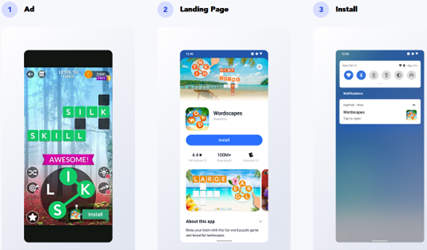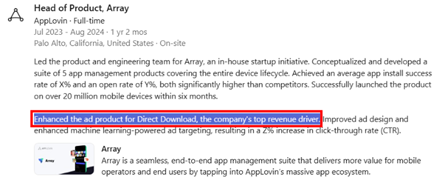This post is part of AppLovin Nonconsensual Installs. See important disclosures.
AppLovin’s “Array” page (now removed, but see Archive.org preserved copy) describes “seamless installs” in which “users choose whether to install.” The page depicts a three-step installation sequence: (1) AppLovin presents an ad, (2) AppLovin presents a landing page with an oversized bold blue “Install” button, and (3) installation is complete.

But AppLovin’s page never promises that this three-step process is always used. In fact, it labels the screenshots as an “example,” leaving open the possibility that some installations proceed differently. Could AppLovin sometimes skip the landing page (Step 2)? If so, the process would lack any moment where the user presses “Install” or otherwise agrees to install.
Other AppLovin materials suggest this must happen. For example, AppLovin AppHub JavaScript settings refer to “Download apps with a single click.” Since clicking an ad is already one click, a second click on “Install” would make two clicks—not one. This suggests that in at least some cases, Step 2 is omitted, as confirmed by my code review, which points to an “AutoInstall” path.
Meanwhile, AppLovin makes strong claims that users “choose” to install apps:
- A February 26, 2025 post from AppLovin CEO Adam Foroughi: “Every download results from an explicit user choice—whether via the App Store or our Direct Download experience.”
- AppLovin Array Privacy Policy (archived copy): “Direct Download … facilitates the on-device installation of mobile apps that you choose to download.”
- AppLovin Array Terms states that “Direct Download … facilitates the on-device installation of mobile apps that you choose download” and “You decide whether to download and install an application…”
How do we reconcile these statements with the “single-click” option, the “AutoInstall” code, and widespread user complaints? The most plausible interpretation is that AppLovin treats a tap on an ad itself as the user’s “choice” to install—even if the user never presses an Install button. Most users would disagree: ordinarily, tapping an ad only opens Google Play, where a further click is required. And because AppLovin’s “x” buttons are small and tucked in the corner, mistaken taps are especially likely.
If we accept AppLovin interpretation of a single ad tap as a user’s authorization to install, then Foroughi’s statement and the Privacy Policy might be literally true, but still highly misleading.
Contradictory statements about the size of the Direct Download business
The Financial Times reports that Applovin says “direct download business was never a major growth revenue driver”:
AppLovin also had a call with sell-side stock analysts on Wednesday, according to a note from Bank of America. In that call, the CEO assured analysts that the direct-download business was “never a major growth revenue driver,” the analysts wrote. They summarised his comments as saying “AppLovin’s [direct download] revenues are de minimis”.
BofA analyst Omar Dessouky told Alphaville that the direct-download business are distinct and totally separate from in-game downloads, and that competitors Digital Turbine and Unity have a big head-start on that business. As for the App Store policies, there seem to be enough complaints about other companies doing it that the practice isn’t being censured (this one, for example, seems to be about Digital Turbine).
These claims are difficult to reconcile with remarks from ex-employee Jia-Hong Xu, previously Head of Product for AppLovin Array, who wrote on LinkedIn that Direct Download is AppLovin’s “top revenue driver”:

Xu later deleted that remark. But on his own initiative, or under pressure from AppLovin (after investor Culper Research highlighted the claim in a February 2025 report)?